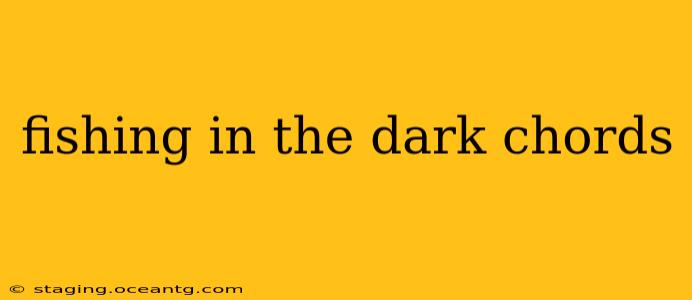Fishing in the Dark: Chords and More for the Iconic Night Owl Tune
"Fishing in the Dark" by the Nitty Gritty Dirt Band is a timeless classic, beloved for its catchy melody and relatable lyrics. For aspiring musicians, learning the chords is a rite of passage, opening the door to performing this unforgettable tune. This guide will explore the basic chords, variations, and some tips to help you master this country-rock gem.
The Basic Chords:
The beauty of "Fishing in the Dark" lies in its simplicity. The song primarily uses a handful of common chords, making it accessible to beginners and experienced players alike. Here are the main chords you'll need:
- G: A staple in country music, the G major chord is the foundation of this song.
- C: The C major chord provides a nice contrast to the G.
- D: The D major chord adds a bit of a lift, creating dynamic changes.
- Em: The E minor chord brings a touch of melancholy, perfect for the song's reflective mood.
Understanding the Chord Progression:
The core chord progression of "Fishing in the Dark" is relatively straightforward. While there are subtle variations throughout the song, the main progression revolves around these four chords. You'll find that the song frequently moves between G, C, D, and Em, creating a comfortable and familiar feel. Precisely how these chords are arranged and strummed dictates the nuances of each section, offering an opportunity for creative expression.
What are the easiest chords to learn for "Fishing in the Dark"?
The easiest chords to learn for "Fishing in the Dark" are undoubtedly G, C, and D. These are foundational chords for many beginner guitarists, and their simple finger placements make them accessible to learn quickly. Mastering these three will give you a solid foundation to build upon.
Are there any variations in the chords used throughout the song?
Yes, while the main progression relies on G, C, D, and Em, there are subtle variations and embellishments throughout the song. These might involve briefly using a 7th chord or employing a different strumming pattern to create dynamics and interest. Listen closely to the original recording to identify these nuances.
What strumming pattern is used in "Fishing in the Dark"?
The strumming pattern in "Fishing in the Dark" is relatively simple, but adaptable. A basic down-down-up-down-up rhythm works well, but experimentation is encouraged. Feel free to add your own stylistic flourishes to create a personalized interpretation. Listening to the song is key to understanding the nuances in the original strumming.
Can I play "Fishing in the Dark" on other instruments besides guitar?
Absolutely! "Fishing in the Dark" is easily adaptable to various instruments. Piano, ukulele, and even harmonica can all be used to play the song effectively. The simplicity of the chords makes it a great choice for many instruments.
Tips for Mastering "Fishing in the Dark":
- Listen to the original: Immerse yourself in the original recording. Pay close attention to the strumming patterns, chord changes, and overall feel.
- Practice regularly: Consistent practice is key to mastering any song. Start slowly, focusing on accuracy, and gradually increase your speed.
- Use a metronome: A metronome helps develop your timing and rhythm.
- Experiment with variations: Don't be afraid to experiment with different strumming patterns and chord voicings to create your own unique interpretation.
Learning "Fishing in the Dark" is a rewarding experience for any musician. Its accessible chords and captivating melody make it a perfect choice for beginners and seasoned players alike. So grab your instrument, start strumming, and enjoy the journey of bringing this country-rock classic to life.
